why are you looking here? he/him, Tails fan, mostly reblogs.
Last active 3 hours ago
Don't wanna be here? Send us removal request.
Text

Some concept sketches for my Sonic Big Bang 2025 piece!
155 notes
·
View notes
Text
🎶 HAPPY BIRTHDAY SONIC 🎶
Sonic's cousin is here to sing him a little birthday song 🎉✨🎶
564 notes
·
View notes
Text
The Shatterverse: Storytelling Through Symbolism
It seems like a lot of people watched Sonic Prime expecting something like Across the Spiderverse: an exploration of canon lore through alternate realities where their favorite characters might have ended up differently (especially dead characters), and the moral dilemma of choosing between saving Sonic’s original friends by sacrificing their Shatterverse alternate versions, or letting them live and losing his original home forever. Alternatively, people just wanted to see their favorite secondary characters again, and a plot centered around the multiverse sounded like a good opportunity to bring back characters like Blaze (who comes from another dimension), or Silver (who is a time-traveller).
But none of that is what Sonic Prime is about. What we got instead was an emotional journey centered on Sonic and his relationships. To fans of the franchise expecting something epic or dark, or as many character cameos as possible, of course this would feel like a letdown. But that doesn’t mean the story is wasting potential: the potential of alternate realities is simply used in a different way, which relies heavily on symbolism for storytelling. And the ending may be controversial (especially the parts that are left ambiguous), but it also serves the message of the story. First and foremost, Sonic Prime is a story about friendship, communication and healing: however you interpret the ending, all the events that took place mattered because the main characters grew from them.
I will elaborate under the cut, but be warned that this essay will be spoiler heavy for the entirety of the Sonic Prime series: I would advise watching it before reading if you haven’t yet. In part 3, I will also be spoiling three stories that I am using for comparison, specifically their endings, because the way they get their messages across is very similar to Sonic Prime. Namely: the movie Jumanji (the 1995 version) by Joe Johnston, the animated movie Spirited Away by Hayao Miyazaki, and Neverending Story by Michael Ende (the novel, not the movie: their endings are very different). Unfortunately, Tumblr doesn’t have a ‘hide spoilers’ feature, so instead, I will use emojis as brackets for these parts: 🎲 for Jumanji, 📖 for Neverending Story and 👻 for Spirited Away, so you can skip those parts if you only want my analysis of Sonic Prime. This post is also very long and image heavy; over 9K words of analysis. I hope that’s fine with you! Here are the three parts’ titles to sum up my main points:
1) The Shatterverse Symbolism: Unstable or Damaged Relationships in Need of Healing
2) Dehumanization and Projection: Who Is ‘Real?’
3) A Defense of Ambiguous Endings: What’s a Paradox?
1) The Shatterverse Symbolism: Unstable or Damaged Relationships in Need of Healing
From the get go, Sonic Prime heavily relies on metaphors and symbolism for storytelling. Sometimes explicitly (like the palm tree being a symbol of connection), other times more subtly: the very landscapes where the action takes place are more conceptual than concrete, and that’s before reality gets broken. (Although, as it will become apparent in part 3 of this essay, time itself is relative in Sonic Prime.)
To understand this point, you have to look no further than the way Sonic talks about Green Hill at the start of the very first episode: "Home is where your friends are, as they say; and that’s Green Hill."
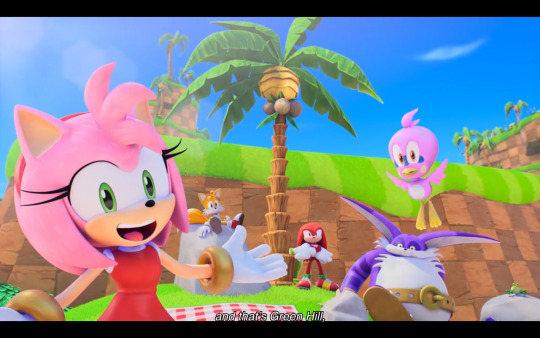
Green Hill is not described as ‘the place where everyone lives together’ or ‘where Sonic’s house is’ (the closest thing to a conventional house we see is Tails’ workshop, and in the games, he has several of those in different places): instead, Green Hill is a symbolic place that represents the entirety of Sonic’s world, emotionally and literally. We can infer that his world is not that small (he does add that Green Hill has "the best beaches, palm trees and chili dogs," so there must be other places to compare them to), but it’s all we need for the purpose of the story, which is why we never get to see what’s past Green Hill’s borders, and no other place within Sonic’s universe is ever mentioned in-story.
Once in the Shatterverse, ‘Green Hill’ becomes synonymous with ‘Sonic’s home world,’ in the same way the dystopian world New Yolk is reduced to a single city. ‘Green Hill’ encompasses everything Sonic lost by shattering his reality: his home, everybody he knows, and his relationships. Green Hill and Sonic’s friends are undistinguishable from each other: home is not a single physical place, it’s the people you want to go back to. And Sonic, being a free spirit who can go wherever he wants, fails to see the fragility of a home, even if he treasures it - because he can’t imagine losing it. Until he does.
The symbolism goes further to serve the story’s message. There is a reason it is called the ‘Shatterverse’ and not the Multiverse: those are not just parallel worlds, they are all ‘broken’ worlds in some capacity, and their inhabitants are as well. Notably, reality ‘shatters’ in ways that reflect the central characters’ issues:
Eggman’s greed and megalomania make him hold on to the Paradox Prism as it breaks: consequently, he gets shattered into five different versions of himself (as many as there are Prism Shards) of varying ages (because the Prism affects space and time), who all end up trapped in the same world, fated to always argue with each other over who is really in charge. The Chaos Council is the perfect foil for Sonic: they don’t love anyone, not even themselves, will use any means necessary to get what they want regardless of who gets hurt in the process, and are never satisfied. But they are also similar to Sonic in ways that cement their status as foils: they are all reckless, tend to act before thinking (especially when provoked), and they never give up. This is what leads them to make a similar mistake to the one Sonic made by breaking the Prism in spite of Tails’ warnings: in their case, they disregard Nine’s warnings about leaving interdimensional portals open for too long, and their negligence causes the entire Shatterverse to start decaying.
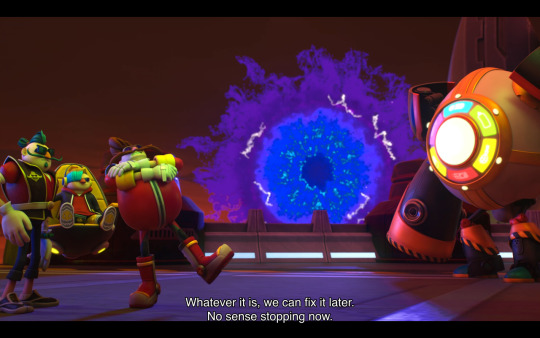
Symbolically, it’s an effective parallel to the cataclysm Sonic caused: his was made with the intent to prevent disaster using the wrong method, it was brief and highly destructive, but entire worlds were born from it (even if all of them were unstable in their own way) - it was akin to a Big Bang, and Sonic makes it his goal to fix what he broke. The Chaos Council on the other hand polluted the Shatterverse for purely selfish reasons, condemning the Shatterspaces and all their residents to a slow death. And unlike Sonic, even if they can learn from their mistakes and accept a truce long enough to save their own skin from the danger they caused, the members of the Chaos Council are incapable of true emotional growth or meaningful connection with others: which is why, in the end, infighting causes their downfall.
Sonic on the other hand breaks reality due to his overconfidence and disregard for the danger the Paradox Prism represents, and the fact that he was relying on his friends without actually listening to them (taking their unconditional support for granted): consequently, Sonic ends up alone in a hostile universe, and gets burdened with the energy of the Paradox Prism - a power he never wanted and can’t properly wield or control on his own. The Prism energy in his body is unstable, upsets his speed, and makes Sonic a living target for anyone who wants his power. Upon realizing his predicament, Sonic immediately goes looking for his friends, only to realize none of the familiar faces he finds remember him, and that all the Shatterspaces (as Nine calls them) are deformed versions of Green Hill where none of the friendships are stable:
New Yolk is a dystopia where Eggman won and built a tyrannical city. Sonic’s friends either got enslaved (Rusty Rose and Citizen 1998), isolated themselves completely (Nine), or are too busy resisting the oppressive power to form any connections outside of the Resistance (Renegade Knux and Rebel Rouge - who have the closest thing to a stable, mutually trusting relationship, but in a context where they constantly fear for each other’s lives and are solely focused on defeating the Chaos Council)
Boscage Maze is an overgrown jungle where nature became unbalanced over time: Thorn Rose is so determined to protect the environment that she is willing to sacrifice her former friends for it by banishing them, and the rest of her former group is reduced to a life of constant paranoia where they scavenge what they can to survive, always on the lookout for the ‘monster’’s next attack
No Place is a flooded world where everybody is a pirate: they seem laid-back and friendly at first, but it quickly becomes apparent that reputation is everything in their world, and Captain Dread’s new crew has been wandering aimlessly since his fall from grace (which is a taboo subject on their ship), and gets regularly picked on by his former crew: under their merry façade, they are adrift in every sense of the word
The Grim is an empty wasteland - nobody lives there
the original Green Hill has been reduced to a colorless ghost of its former self, where echoes of Sonic’s friends repeat a single line over and over: Ghost Hill
These worlds are all ‘shattered’ in a physical and sociological sense, which illustrates the many ways in which what Sonic took for granted can go wrong. It’s a classic case of "you never appreciate what you have until it’s gone," which serves as Sonic’s first wake-up call and starts his character arc.
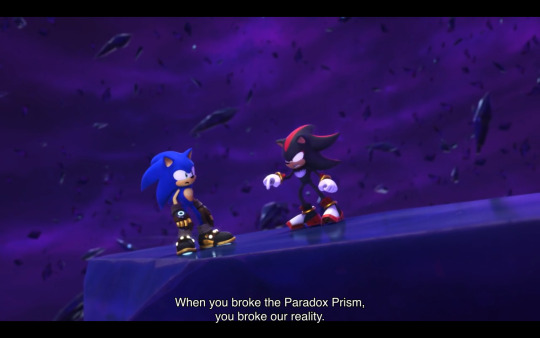
The only relationship Sonic gets to keep in the Shatterverse is the one he can’t define: his rivalry with Shadow. In his introductory speech, after stating that ‘home is where your friends are,’ Sonic divides his acquaintances into friends (Tails, Amy, Knuckles, Rouge, Big and Froggy - not necessarily his only friends, but in Sonic Prime, those six represent his friendships in general), enemy (Eggman) - "and then there is Shadow. It’s… complicated." Shadow is immediately introduced as the odd one out, not quite fitting in Sonic’s definition of ‘home’ even if this world is Shadow’s as much as it is Sonic’s. This is due to the fact that we are mainly experiencing the story from Sonic’s perspective as the focus character, and Sonic doesn’t know where he stands with Shadow.
Symbolically, it’s very meaningful that Shadow is the only Green Hill survivor: he didn’t quite fit in Sonic’s friend group, which is why he is the first to realize that Sonic is upsetting the balance. Unlike the others, he doesn’t trust Sonic enough to simply warn him: as soon as he sees that Sonic poses a threat to the world (intentionally or not), Shadow immediately attacks him. It establishes his character as someone who takes action without relying on anyone else, willing to take down anyone standing in his way for the sake of protecting his world, but terrible at communication. (He never properly explained to Sonic why he suddenly attacked him beyond "You just shook the world!") Later on, Sonic boils it down to Shadow having trouble trusting anyone - he would rather rely on his own power.
Which is why Shadow ends up trapped in an empty Void between worlds, only able to access the ghost version of his former home, essentially powerless. Naturally, Shadow’s first reflex is to take back control of the situation and claim back his autonomy by stealing Sonic’s ability to travel between Shatterspaces, with the intent to fix reality himself. (As Shadow points out, he has no reason to trust Sonic after seeing him literally break reality - even Sonic can’t deny that much.) However, Shadow is forced to realize that this power is not something he can take, because Sonic himself is the key, not the tech he uses.
Emotionally, this scene is pivotal for Shadow in more ways than one: not only did he fail to forcefully trade places with Sonic and take control, Sonic saved his life after the failed attempt nearly got Shadow killed. It naturally leads to his realization that Sonic carries the power to travel between Shatterspaces in his own body (symbolically, Sonic is the glue that brings the Shatterspaces and their residents together), and him acknowledging that he and Sonic need to work together to fix reality.
That makes Shadow a missing piece: even back when Green Hill was whole, his relationship with Sonic was strained. Ironically, their reality shattering becomes an opportunity for them to build something new by learning to trust and rely on each other.
What’s especially interesting is the way their perception of the Shatterspaces and their residents evolves over time, along with their understanding of relationships - what they define as ‘real.’
2) Dehumanization and Projection: Who Is ‘Real?’
This is a question for us viewers as well: what exactly are the Shatterspaces and their residents?
Instead of a detailed exposition or definite answers, Sonic Prime gives us food for thought: across the series, different characters theorize about what the Paradox Prism does and what the Shatterspaces are, but they all draw different conclusions depending on their perspective and the limited information they have at any given time. It’s up to us to decide which theory is the most likely to be correct, or if the answers lie elsewhere.
When Sonic first lands in New Yolk and sees remnants of a destroyed Green Hill underneath the city, he initially assumes that he just ended up in a future of his world where Eggman won. Later on, when Sonic finds a single Prism Shard in New Yolk instead of the whole Paradox Prism, he realizes that New Yolk is a different world entirely: he finally recovers the rest of his missing memories, and concludes that he created this dystopian world by shattering the Prism.
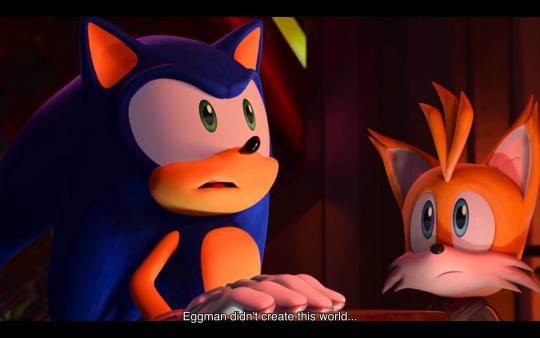
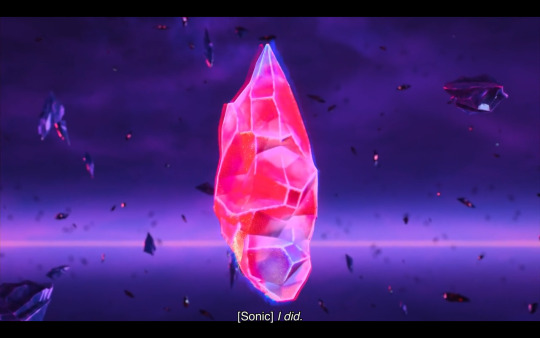
Until this moment, Sonic was clinging to the belief that the familiar people he met were simply future versions of his friends who had forgotten him: he keeps calling them by the wrong names, introducing them to each other based on what they were like in his world, and repeatedly says things like "when you get your memories back."
At this point, Sonic was still confused by his missing recent memories, but even when he does remember and lands in Boscage Maze after getting absorbed by New Yolk’s Prism Shard, Sonic still clings to denial and the hope that the familiar faces he meets there will finally recognize him. He gets more and more distressed when people he sees as friends keep attacking him, and can’t help but try to bring back memories they don’t have, because he has gotten that desperate for connection - which is why Prim is able to manipulate him so easily, and why he doesn’t see Thorn’s backstabbing coming, even if they both have been hostile to him from the start. In short: in these two first worlds, Sonic is constantly projecting his Green Hill friends onto the Shatterspaces’ residents.
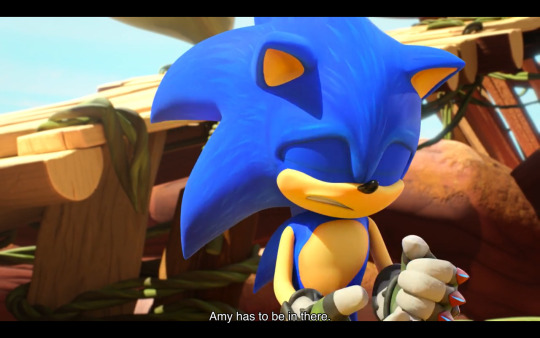
Interestingly, this tendency proves useful in Boscage Maze: because Sonic can’t help but see Amy in Thorn, he can’t dehumanize her the way Prim and her group do by calling Thorn a ‘monster.’ And Sonic can’t agree with Thorn either when she dehumanizes her former friends by calling them ‘scavengers;’ which, in her mind, justifies her banishing them and letting them waste away above the jungle canopy: her goal of protecting the forest blinds her to everything else. In the end, Sonic is able to use his memories of what Amy tried to teach him about communication, connection and balance to bring Thorn to her senses. In a way, he is still projecting, but in the sense that Sonic knows who Amy is at her core, and her potential: to reflect this, he starts to say ‘you’ and ‘her’ interchangeably for Thorn and Amy as two variations of the same person:
Sonic: Well, my friend Amy would say: "Talk about your feelings." But she’s a little corny. Thorn: I don’t know - she sounds pretty great. Sonic: Yeah. You are.
In a sense, Amy is the one saving Thorn from herself through Sonic, who finally understands the value of connection his friends were trying to express by gifting him the palm tree, back in Green Hill. Finding alternate versions of the palm tree in both New Yolk (as the last remnant of their home that the Resistance is trying to protect in the hopes of bringing nature back one day) and Boscage Maze (as the ‘Great Green’ that Thorn worships, not realizing that the palm tree is dying due to the lack of sunlight ever since she shut her friends out, figuratively and literally, and the power of the Prism Shard made the jungle overgrow) reinforces the idea that “everything is connected.” Sonic also realizes that the Shards are a source of discord, and tells Thorn as much, making the metaphor explicit:

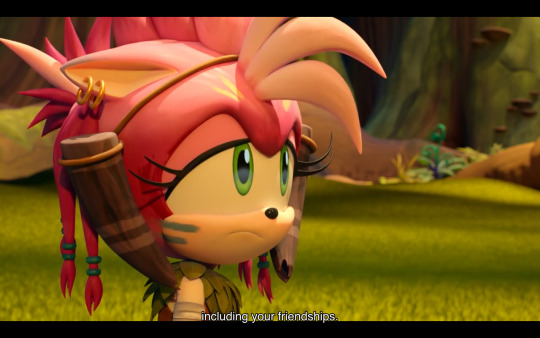
All this leads Sonic to think of the Shatterverse residents as versions of his friends in different circumstances, who never got to meet him and whose realities got corrupted by each Prism Shard. From then on, Sonic actively tries to acknowledge the Shatterspaces as alternate realities: when he gets to No Place, he chastises himself for the parallels he can’t help but draw between Dread and Knuckles, and acts a lot more distrustful towards the pirates after getting attacked so many times in the previous worlds.
Sonic: But no - you’re pirate Knuckles! I’m not taking any chances!
Ironically, Dread is very welcoming initially. His friendly attitude strengthens Sonic’s impression that deep down, they are just like their Green Hill counterparts, and he finally gets an opportunity to take a break and just enjoy time with familiar faces who are actually nice to him for once. Moreover, Sonic is delighted to meet someone he sees as a fun-loving version of Knuckles, and actually calls Dread his "favorite version of Knuckles" to his face.
Only to later realize that the pirates have their own issues centered around another Prism Shard, aptly named ‘The Devil’s Lighthouse,’ a fabled gem with unfathomable power that every pirate covets: going after it, ignoring his former crew’s warnings and sinking his former ship is what ruined Captain Dread’s reputation years ago. Dread tells Sonic to forget about the Shard, because the pirate is well aware that he is likely to relapse and get blinded by greed again if they go after it. (In the same way that Thorn "lost herself in the darkness" of the overgrown jungle after abusing the power of the Shard she calls ‘the Heart of the Forest.’) Which seems to support Sonic’s theory that the Shards bring unbalance to their respective Shatterspaces.
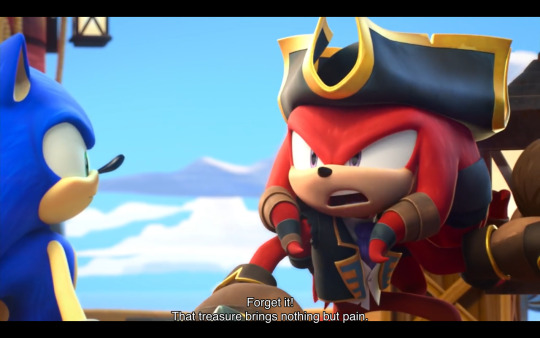
Sonic inevitably gets dragged into the mess regardless, which makes him miss his home even more.
Parallel to all this, while travelling through the Shatterspaces, Sonic gets visions of Shadow urging him to keep going, and trying to tell him that he is trapped in the Void. Sonic is very confused by this, and assumes he is hallucinating - yet when Shadow tells him to keep running without stopping, Sonic listens, even as he is running straight towards a wall.
It does pay off, because going fast is the key to activate Sonic’s ability to teleport from one Shatterspace to another, but Sonic didn’t know it for sure at the time. Despite this, and his doubts that this Shadow he keeps glimpsing is even real, just from the urgency in his voice, Sonic chooses to trust him.
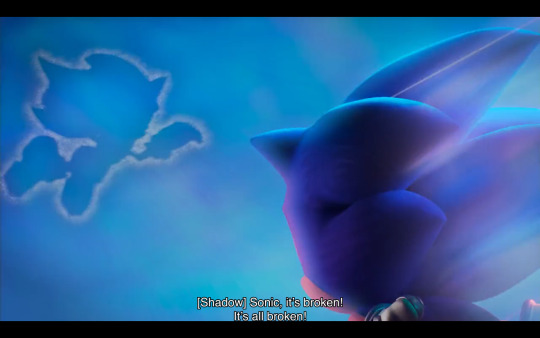
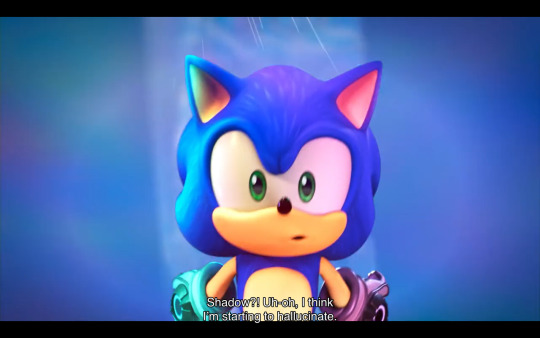
It all comes to a head when Shadow finally manages to intercept Sonic in the Void between Shatterspaces. Initially, Sonic assumes he just landed in a new world with a different version of Shadow. Only this time, Sonic is out of patience:
Sonic: Look, I have no time to deal with whoever you are. I just wanna go home.
Which naturally sets Shadow off because Sonic is the one who destroyed their home in the first place. It takes Shadow saying his name for Sonic to finally realize that the Shadow in front of him is the one he knows from Green Hill; and the way Sonic reacts is very telling:
Sonic: Shadow! You’re… you! The real you! Shadow: The only me!
This outburst shows that, deep down, Sonic still sees the people of Green Hill as the ‘real’ ones, even if he doesn’t fully realize it. He is so relieved to finally find someone he actually knows, then so upset by Shadow’s reveals about Green Hill’s fate, that Sonic has no time to stop and consider the implications of what he said here - but to the viewer, it’s important foreshadowing.
In that same episode, we also get to see Shadow’s perspective, and that the way he views the Shatterspaces is much more radical than Sonic’s. The fact that he calls himself ‘the only me’ has sinister implications: on the one hand, it is true that there are no alternate versions of Shadow in the worlds Sonic has visited (because Shadow teleported out of the way before the Paradox Prism’s blast could shatter him). But more importantly, Shadow is rejecting the very idea that there could ever be other ‘Shadows,’ or any other version of the Green Hill residents. Because, unlike Sonic, Shadow does not see the Shatterspaces as alternate realities: Shadow thinks the Shatterspaces are nothing but "cruel versions to make [them] suffer."
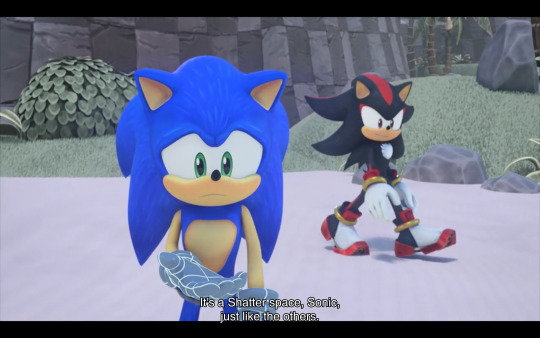
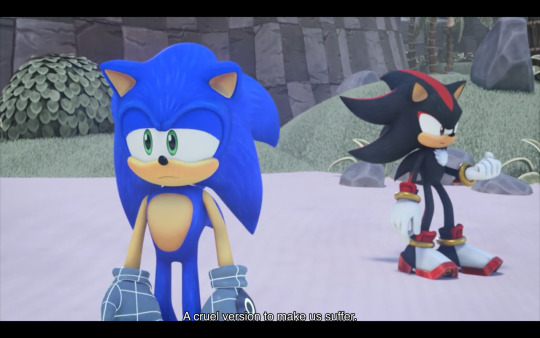
This impression partly comes from the fact that the only Shatterspace Shadow can enter is Ghost Hill, which is incomplete: Shadow himself admits that he can’t figure out whether it’s because this world "is decaying" or "not fully formed." He doesn’t understand why this Gateway is letting him in, either, but to him, it feels "like a ghost." Yet he calls the Shard in the Ghost Hill mountain the "real one," unlike the rest of Ghost Hill and the other Shards, which, according to his theory, create "distorted versions of [their] reality." In short, Shadow doesn’t see Ghost Hill as what remains of his home, but he does see its Shard as a possible chance to get his home back. In Shadow’s eyes, aside from the Shards they need to gather, everything in the Shatterverse is nothing but an illusory obstacle.
Which is why, when Sonic wants to tell Nine about Shadow’s plan to rebuild the Paradox Prism around the Shard in Ghost Hill, Shadow insists that Nine can’t be trusted:
Sonic: What are you talking about? Of course he can! He’s just like Tails! He’s just a little… angsty, that’s all. Shadow: No. He is not Tails, he is Nine. And they are not your real friends!
When Shadow says this, he is not just warning Sonic about the fact that he is clearly projecting, he is saying that none of the Shatterspace residents are actual living people - only illusions. In doing so, Shadow is dehumanizing the Shatterverse residents and making Sonic rightfully fear what Shadow might do to them for the sake of bringing Green Hill (the only ‘real’ world in Shadow’s eyes) back. Hence why Sonic answers by reaffirming that Nine and the Shatterspaces are just as real as they are:
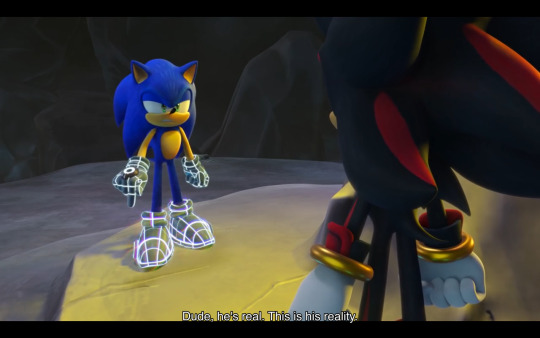
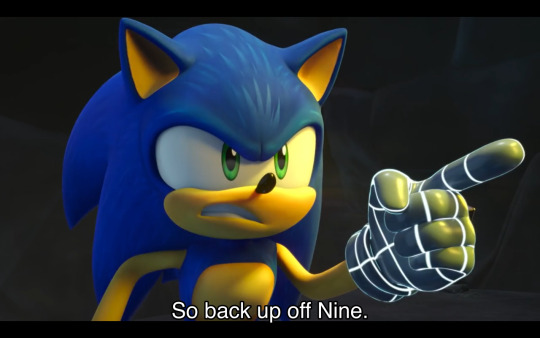
These conflicting views are the reason they fight: Shadow thinks Sonic is deluding himself by thinking of the Shatterverse residents as people, and Sonic wants to protect them from Shadow, whom he knows can be ruthless, especially if he thinks the people in his way aren’t real.
Later on, when the two of them have to work together, Shadow is left with no other choice but to rely on Nine to rebuild the Prism. Shadow is still openly distrustful of Nine, but no longer outright denying that he is ‘real.’ (Possibly because watching Sonic interact with the Shatterverse residents all this time and then meeting Nine face to face made it gradually more difficult for Shadow to deny their personhood.) Instead of telling Sonic off again or confronting Nine directly, Shadow is gentler when he voices his doubts, going as far as to wait until Nine is out of earshot for this exchange with Sonic:
Shadow: How do you know you can trust him? Sonic: Trust is an issue for you, Shadow. That’s why you don’t have any friends. Shadow: I don’t think your ‘friend’ wants the same thing we do.
Even if you can hear obvious sarcasm when Shadow says ‘friend,’ the mere fact that he mentions Nine wanting something different shows that Shadow truly sees Nine as his own person: his distrust no longer comes from the fact that he doesn’t see Nine as real - on the contrary, Shadow sees him as a stranger with his own goals. Unlike Sonic, he sees Nine and Tails as completely separate people; he simply fears that Sonic might be placing his trust in the wrong person. Sonic (rather rudely) dismisses his worries by saying: "Trust is an issue for you Shadow. That’s why you don’t have any friends." The latter may or may not be true (there are subtle hints that Shadow and Rouge are friends in Sonic Prime, but Sonic doesn’t seem to know this, and the series is mainly from his point of view, so there is no way for the viewer to know for sure either), but the former definitely is: Shadow’s trust issues and difficulties to communicate properly are part of the reason he attacked Sonic instead of talking things out at the beginning of the series, and thus failed to prevent the destruction of reality. It is also the reason why they fought when Shadow cornered Sonic in the Void, then fought again over Sonic’s tech in Ghost Hill.
However, things have changed between them since then, especially with them being forced to work together, even from a distance: at this point, Sonic trusts Shadow enough to leave him alone with Nine. Therefore, when the Chaos Council attacks, Sonic leaves the choice up to Shadow: he can stay and keep an eye on Nine while he repairs the Prism if he wants, but Sonic is off to fight the Chaos Council. In the end, even though Shadow still looks conflicted, it doesn’t take five seconds for him to make his choice: he goes after Sonic. Even if Shadow claims that he is just making sure that Sonic won’t mess up again, it is still a leap of faith on Shadow’s part to leave Nine on his own. In spite of his lingering doubts, Shadow is choosing to trust Sonic’s judgement of Nine’s character and their friendship: in and of itself, it’s a show of character growth. (And Sonic is aware of this, which is why he is so happy to see Shadow join him for battle - and also because he is excited about teaming up with him in general.)
Another reason for Shadow’s choice is the fact that Nine has proven his knowledge and ability to handle the Shards: as Sonic reminds Shadow, Nine is the only one capable of restoring the Paradox Prism. Shadow even heard Nine back up his theory that Ghost Hill is "like an embryonic Shatterspace," "like it got stuck in the blueprint stage while forming;" a theory that’s further supported by Sonic’s shoes and gloves looking like blueprints with no special ability in Ghost Hill (even though all the other Shatterspaces give his clothes new abilities thanks to Nine’s tech regulating the Prism energy in Sonic’s body). When Sonic and Shadow take him to the Paradox Prism, Nine warns them both that if they try to restore the Paradox Prism, "the slightest variation can have massive repercussions:"
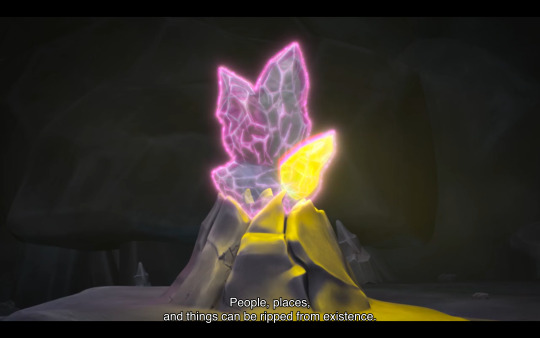
Nine: One small mistake, and poof! Reality is changed forever.
This choice of words has important implications: it suggests that the changes Sonic already caused by shattering the Prism are irreversible. In other words, all the Shatterspaces became real because of Sonic, and they will remain as they are unless Nine makes a mistake while repairing the Prism. Therefore, Nine has much more to lose than Sonic or Shadow if he messes up, which is why Shadow lets him handle it, even if he suspects that Nine has a different motive to restore the Prism.
Unfortunately for Shadow and Sonic, Nine does. In fact, Nine has his own issues with his perception of reality: he grew up in a dystopian world with no one to love him and nobody to love, living underground "to avoid everyone." Before the series even started, Nine’s goal has always been to escape his reality. Initially, he took refuge in solitude, until Sonic’s arrival shook his world literally and figuratively: Sonic is the first person to show him genuine kindness and affection, and speaks of a world where they are best friends and do everything together - a world he lost. Not only that, but Sonic is the one who leads Nine to discover the Prism energy, and through that, a way to travel between worlds by opening portals: as soon as he gets the opportunity, Nine immediately takes the New Yolk Shard for himself and leaves his world behind to explore the Void, without a second thought for the Resistance members he left for dead. Once there, Nine is elated to discover an empty world, which he names ‘the Grim,’ immediately decides to make it his and Sonic’s new home, and persuades himself that Sonic will love this place. Together, they can transform the Grim into a Paradise - everything they ever wanted!
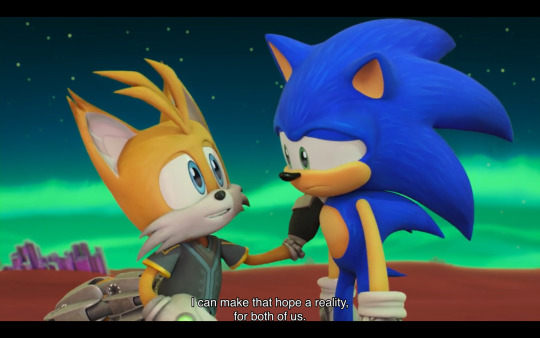
In other words, Nine and Sonic are projecting on each other. Sonic wants to fix his shattered reality, and thinks he can just bring Nine back to Green Hill with him so Nine can have a new home where he can be happy. Meanwhile, Nine wants to create a brand new reality with the only person he trusts, and no one else. The tragedy of their friendship is that, no matter how much they genuinely care about each other, their end goals are irreconcilable.
What’s worse: because they are both constantly under pressure from outside threats, the two of them never get an opportunity to talk things out properly. (When Nine first brings Sonic to the Grim, Sonic can’t give a proper response to Nine’s proposition to live there together because he has to go back to New Yolk to help the Resistance. Then, in Ghost Hill, when Sonic tries to tell Nine that he saw Green Hill briefly pop back into existence while Nine was repairing the Prism, Nine is too focused on his task to listen, and has to send Sonic away to keep the Chaos Council at bay.)
Inevitably, miscommunication leads to disaster when Sonic realizes that Nine never intended to restore Green Hill (Nine doesn’t even believe it’s possible to bring it back), and Nine insists that they have to build a new world because Green Hill “was never (Nine’s) home.”
Nine: Did you even think about what I wanted?! Sonic: I just assumed that after everything we’ve been through, you would see things the way I do. Just like the real Tails would.
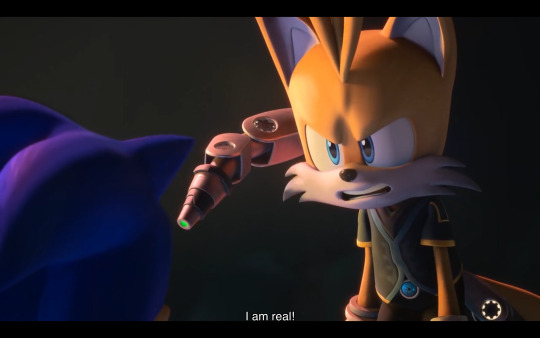
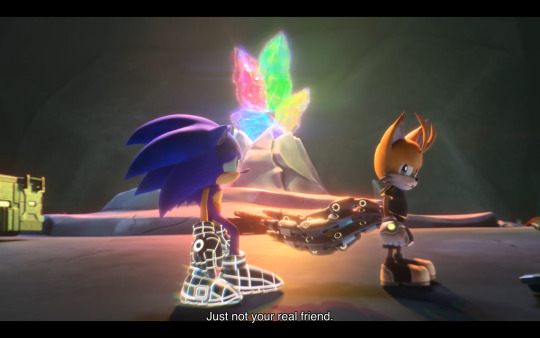
This dialogue sums up everything Sonic Prime is about through the double meaning of ‘real’ in this context. What Sonic blurts out here can be interpreted as a denial of Nine’s personhood: just a replacement for the ‘real’ Tails, whom Sonic never saw as his own person. Of course Nine would be enraged at hearing something like this, and Sonic’s wide-eyed expression and stunned silence at Nine’s outburst speak volumes about how horrified Sonic is at what he just implied with his poor choice of word.
Especially because, as we know, Sonic does see Nine as a real person: he told Shadow as much the first time they went to Ghost Hill. The entire reason they fought was because Sonic wanted to protect Nine from Shadow, who didn’t see Nine as real at the time.
But Nine doesn’t know this, and even if he did, it wouldn’t change the root of the problem: when Sonic brings up ‘the real Tails,’ Nine is forced to realize that Sonic has been projecting Tails onto him all this time, and that Nine can’t compete with Sonic’s ‘real’ best friend from his home world, destroyed or not. In Nine’s eyes, it means that his friendship with Sonic was never real, because Sonic never really saw Nine - only Tails.
And Sonic never considered that Nine could ever see things that way: after all, seeing Amy in Thorn was a good thing. It’s what helped her regain some self-love when she was at her worst, and she certainly didn’t mind the comparison. Similarly, knowing Tails’ abilities allowed Sonic to teach Mangey how to fly. And telling Nine about his past with Tails is the way their own friendship started (symbolized by Nine building the tech that stabilizes the Prism energy in Sonic’s body and allows Sonic to control its powers). Nine was even the one who asked Sonic: "So… So what else did we do?" - expressing a wish to be the fox in Sonic’s stories.
In Sonic’s mind, comparing one friend to another isn’t an issue, because he loves all his friends equally. When Sonic says "the real Tails," or the ‘real’ Shadow, it actually means ‘the one I know’ - as demonstrated by the way Sonic tells Dread: “The Knuckles I know is not a coward.”
But Nine has no frame of reference for friendship. It’s completely new to him, and Sonic is the only friend he ever had. To Nine, love is finite: if there is anyone else in Sonic’s life, that someone can take Nine’s place and "take Sonic away." (Hence his outrage over Shadow helping Sonic escape the Grim in season 3 episode 1: "What?! Shadow thinks he can take Sonic away from me?! Not a chance!") Especially if that someone else is another version of himself: not only are they rivals for Sonic’s affection, they are a threat to Nine’s sense of self. These are the reasons he eventually targets Sails and Mangey: as Tails-lookalikes, not only does he perceive them as a threat to his sense of personhood ("There is only one of me," he says before sending his robots after them. In other words, the other versions of him are not ‘real,’ so it’s justifiable to attack them.) but also as the greatest threats to the reality he wants: a world for him and Sonic only.
And this is yet another form of dehumanization: Nine becomes unhealthily possessive of Sonic, and starts to objectify him. When he realizes that he needs the Prism energy inside Sonic’s body to complete the Prism, he goes after Sonic like a commodity that he is owed, no longer a person he wants by his side. Shadow and the Shatterverse residents all realize that Nine is objectifying Sonic, and all of them are rightfully afraid of what Nine might do to Sonic if he gets his hands on him - which is why they all fight to protect Sonic the same way he has been fighting for them all this time, even with the entire Shatterverse decaying around them all.
Shadow in particular is a great foil for Nine in this instance, because his development and relationship with Sonic, along with the way he views the Shatterspaces and their residents, went in the opposite direction. When Nine steals the Paradox Prism and abandons Sonic and Shadow in the decaying Ghost Hill, we get another pivotal scene that shows how much Shadow has changed since his last fight with Sonic: instead of chastising Sonic for trusting Nine despite his warnings, Shadow’s priority is to escape Ghost Hill with Sonic, who is understandably upset and reluctant to leave the Ghost versions of the Green Hill residents behind - and Shadow has to insist that they aren’t real and can’t be saved. And when that’s not enough to persuade Sonic, Shadow finally recognizes that the other versions of their friends in the Shatterverse are the ‘real’ ones: "the ones who still have a chance."
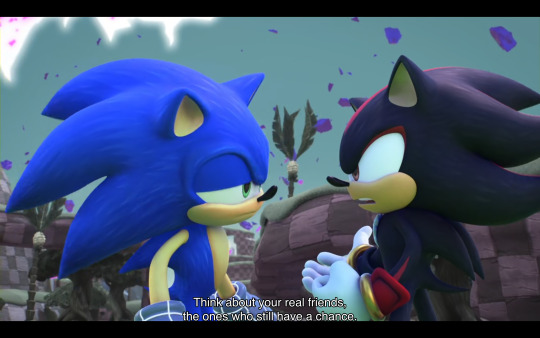
At this point, it could be argued that Shadow is mainly saying this as a way to persuade Sonic to leave, rather than telling him to save himself (because Shadow knows that Sonic always prioritizes saving people over his own safety). But it still reflects the fact that Shadow is finally starting to view the residents of the Shatterverse as their own people, and Sonic’s friendship with them as genuine: a clear contrast to his previous allegation that "they are not your real friends!"
On the other hand, Shadow still views the Green Hill ghosts as ‘not real’ - something Shadow, Nine and Sonic all thought initially. Only for the ghosts to briefly pop back into existence while Nine was repairing the Prism - which proves that their true selves are in there somewhere. Sonic is the only one who witnesses it, which is why he is so reluctant to leave the ghosts behind: unlike Shadow and Nine, Sonic knows they can be saved. Furthermore, them reappearing did not affect Nine or the Chaos Council, which also disproves the common fan theory that none of the alternate versions can exist at the same time as the Green Hill characters, or that they would just fuse back together if the Prism got restored. This scene proves to Sonic and the viewers that all of the characters we met are real.

Symbolically, it also deconstructs the notion that love and friendship are finite: that you can’t love someone ‘as much’ as someone else. (Nine definitely believes this, which is why his immediate assumption is that he was a replacement for Tails all along, and that there can be only one of him). In actuality, Sonic cares about everyone equally; he loves them differently, yes, but equally, which is why he refuses to leave anyone behind when the Shatterverse collapses and Nine targets the stranded pirates in No Place to lure Sonic into a trap. Others (in and out of the show) criticize Sonic for walking into this trap knowingly, but the narrative doesn’t, in this instance: prioritizing his friends was the lesson he had to learn in the first place, rather than ‘solving the situation;’ and then, learning to listen to them.
Nine in particular is the main reason Sonic has come this far, either directly or thanks to the regulators he built so Sonic could control the Prism energy in his body and travel from world to world - and making new connections there. Therefore, it only makes sense symbolically that Nine and Sonic’s fallout would bring the end of the world.
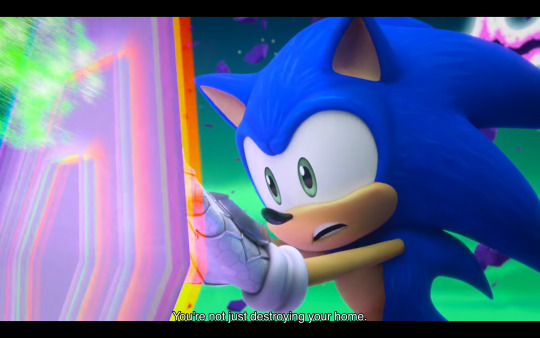
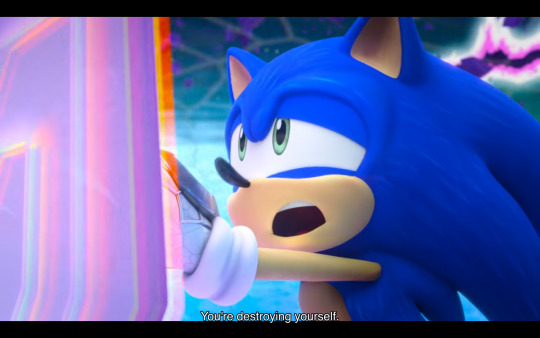
Season 3 focuses on the toll that using the Prism’s power is taking on Nine and the entire Shatterverse: it follows the pattern of the Shards bringing discord and unbalance. The more power he uses, the more self-destructive Nine becomes (attacking his two alternate selves is yet another symbol of his self-destructive behavior), until he purposefully accelerates the Decay to draw Sonic into a corner, which makes Sonic’s friends (and the Chaos Council) all the more determined to take Nine down, leading to more destruction. And as Nine’s only friend, Sonic is the only one who can stop it by interposing himself, finally calming Nine down. (On that note, as far as symbolism goes, it is very fitting that the last use Sonic makes of his Prism energy is to use Nine’s tech to protect them both from everyone else with a summoned shield.)
In fact, Sonic has been consistently prioritizing saving people over gathering the Shards in the series, and always refused to lose faith in his friends, even after getting betrayed and becoming more cautious - because he believes in their potential to be better. So, when left with no other option, it’s only natural for Sonic to sacrifice the Prism energy in his body to save everyone else. And when Nine expresses astonishment that Sonic would do this even after everything he did, Sonic simply answers: "What are friends for?"
The Shatterverse getting restored at the end is symbolic of Sonic’s relationships (and all the others’) being mended. It’s especially important that Nine is the one to do it, because everything started due to a misunderstanding between Sonic and Tails (when Eggman tricked Sonic into unearthing the Paradox Prism despite Tails’ warnings), and escalated with a much bigger misunderstanding between Sonic and Nine: their reconciliation and restored mutual trust is what saves the universe. Not only does Sonic decide to protect Nine despite his betrayal, he has to persuade the others to also put their trust in Nine and let him extract Sonic's Prism energy to restore the Paradox Prism and fix reality, even if it puts his own life at risk. They reluctantly agree, because they all realize that there is no other option if they want to live. Symbolically, choosing to trust someone who can help while knowing the risks is necessary to start healing and move on.
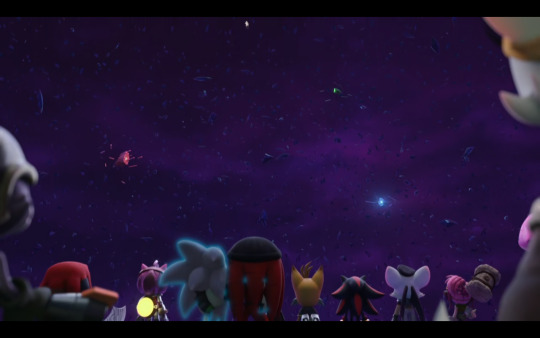
Afterwards, every character working together to bring home a dying Sonic reinforces this symbolism: for once, Sonic is the one reduced to complete powerlessness, being rescued by his friends, coming home literally and figuratively. After all: "Home is where your friends are."
As for what happens to the rest of the Shatterverse and its residents after Sonic and Shadow get home to Green Hill, or to the Paradox Prism after Shadow teleports it away…
We don’t get to find out.
And maybe that’s the point.
3) A Defense of Ambiguous Endings: What’s a Paradox?
This is where I bring up Jumanji, Spirited Away and the Neverending Story novel for comparison. Why those three stories? Well, I can think of a few similarities between them and Sonic Prime: all of them center on characters who leave their world behind and have to find their way home without losing themselves or their loved ones. Jumanji in particular neatly sums up the stakes in the very rules of the titular magical board game:
"Jumanji: a game for those who seek to find a way to leave their world behind. Adventurers beware: do not begin unless you intend to finish. The exciting consequences of the game will vanish only when a player has reached Jumanji and called out its name."
Thanks to these rules, we know the destination from the get-go, and that reaching it will erase the entire adventure - the only question is if and how the characters can make it to the goal.
But if they do reach their goal and erase everything, does it render the adventure pointless? Or does something remain, in the end?
What about a story that ends with unanswered questions? 📖👻🎲Just like Sonic and Shadow or Alan and Sarah, both Bastian (the ordinary child who reads the titular Neverending Story and gets absorbed into the written world of Fantasia) and Chihiro (a young girl who gets trapped in the Spirit World after going through a mysterious tunnel with her parents in the beginning of Spirited Away) make it home at the end of their respective stories. But the book Bastian fell into disappears, and Chihiro’s parents don’t remember anything from the Spirit World. There is no way to confirm what becomes of their respective guides Atreyu and Haku, or any of the other people from Fantasia or the Spirit World.📖👻🎲
Does that make those stories ‘unfinished?’ Or is the lack of answer part of the point those stories are trying to make?
In Sonic Prime’s case, the very fact that the cataclysmic object that starts the plot is called the Paradox Prism has me fully convinced that the ambiguity is entirely intentional and part of the plot.
A paradox is contradictory by design: it invites critical thinking and encourages you to think outside the box. And just like the Shatterspaces, there is a reason why the Paradox Prism is called the way it is: its very name hints at its powers in more ways than one.
In this case, the events of Sonic Prime rely on a time paradox: Sonic fell into the Shatterverse because the Prism got broken, and yet, before this, Shadow saw a vision of himself in the Void, trying to reach Sonic through the New Yolk Gateway.
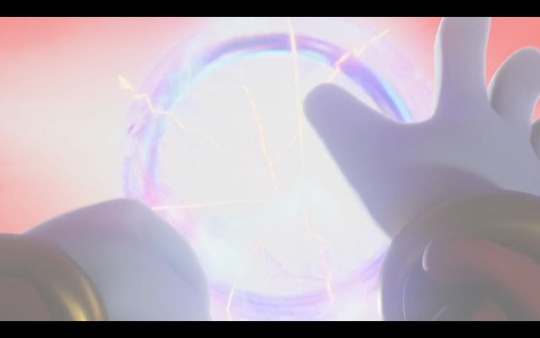
Shadow got this vision as soon as the Prism got unearthed, when Eggman tricked Sonic into powering the blast that fractured the mountain - before the Prism got broken. This vision is what drew Shadow to attack Sonic, because it forewarned him that Sonic was about to shake reality. (Shadow couldn’t tell how exactly, which is why he demanded answers while attacking Sonic - but unfortunately, Sonic had no idea what Shadow was talking about because he didn’t realize that the blast did anything more than damage the mountain.) In other words, Shadow saw Sonic in New Yolk and himself in the Void before the Shatterverse was even created.
It is a paradox, yes, but a paradox that makes sense in the context of Sonic Prime. Because, as it turns out, time flows differently in each Shatterspace: a day in Boscage Maze equals several weeks in New Yolk - in other words, time flows faster in New Yolk, which explains why chronologically, Sonic would already be there before the Prism got broken in Green Hill: what Shadow saw wasn’t a vision from the future, it was a vision of what was already happening in New Yolk. Shadow wasn’t shocked by this, because he is already used to time and space manipulation (that’s what Chaos Control is): he immediately understood that the space-time continuum got damaged, and that Sonic was the cause, because Shadow made the connection between the blast and the Sonic he saw in the Void. This knowledge is what allows Shadow to save himself from shattering: he uses Chaos Control to avoid the blast when Sonic shatters the Prism, and lands in the Void instead.
The resolution of the series follows a similar logic: when Green Hill gets restored, Sonic is brought back to a frozen moment right before the Prism gets shattered (the point in time where the Shatterverse was created), but still has memories of the Shatterverse, because Shadow brought him back through the Gateway before he could disappear - symbolically making their world whole: after Green Hill got restored along with the rest of the Shatterverse and Gateways, Sonic and Shadow were all that was still missing.
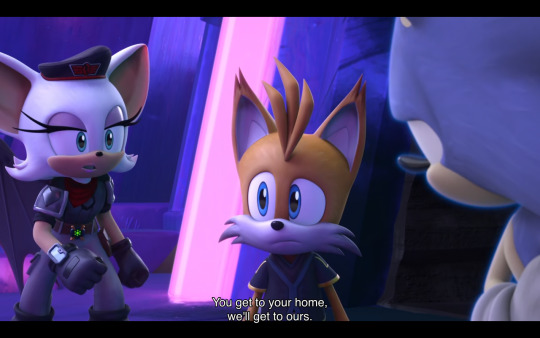
Since it has already been demonstrated that Nine and the Chaos Council could still exist even when the Ghost Hill characters got briefly restored to their former selves, it stands to reason that the rest of the Shatterverse works the same way: this is why the alternate versions of his friends tell Sonic to go back to his world while they go back to theirs. Later on, Sonic ends the time paradox by letting Shadow teleport the Paradox Prism away before it can get broken again, but the fact that it already got broken once in a different reality might be enough for the Shatterverse to keep existing (it is certainly implied by Shadow’s vision of himself in the Void before the Prism got broken).
But if that’s the case, why don’t we get confirmation with a scene showing what has become of the Shatterspaces after Sonic and Shadow got home?
Because the ambiguity is part of the point Sonic Prime is trying to make: the series is focused on Sonic, his point of view, and what he learnt from the journey, so the end of his journey is the only one we get to see. Part of saying goodbye to your friends is not being sure what becomes of them - but trusting that they are going to be okay after they sent you back home.
The same goes for the Shatterverse residents: Nine in particular has to let go of his possessiveness of Sonic and give him a way home to save his life - a fitting illustration of the saying: "If you love someone, set them free." And just like Nine, the other residents of the Shatterverse each do their part to get Sonic home, even if none of them can confirm that he and Shadow made it back safely; all they can do is trust that they both did. Hence Dread’s words of farewell to Sonic: "And know we’ll be rooting for ya!" Even if they never see each other again, the support is still there.
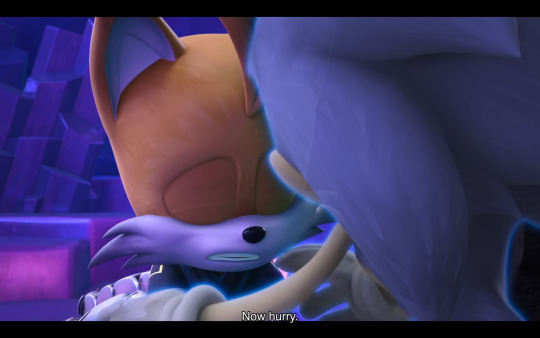
📖👻It is similar to the way Bastian and Atreyu have to part ways in Neverending Story (Atreyu promises to finish the stories that Bastian couldn’t complete in Fantasia, which allows Bastian to escape the book and get his memories back), as well as Chihiro and Haku in Spirited Away (Haku brings Chihiro back to the tunnel leading to the human world, but he has to stay behind in the Spirit World - he still promises to see her again one day).📖👻
🎲 And to a lesser extent, it is also similar to the way Alan and Sarah get separated from Judy and Peter in Jumanji: the game of Jumanji that Alan and Sarah started in 1969 lasted 26 years, and they could only finish it with the help of Judy and Peter, two children they meet in 1995; therefore, when they finish the game, Alan and Sarah are brought back to their original time, where Judy and Peter don’t exist - and Sarah feels that she is starting to forget what being an adult feels like.
"It’s okay," Alan tells her. "As long as we don’t forget each other." "Or Judy and Peter," Sarah adds: Judy and Peter might not exist yet, but Alan and Sarah know enough to save their parents when the time is right - just like Sonic and Shadow know enough to trust each other and resolve to protect the Prism so their reality doesn’t shatter again. 🎲
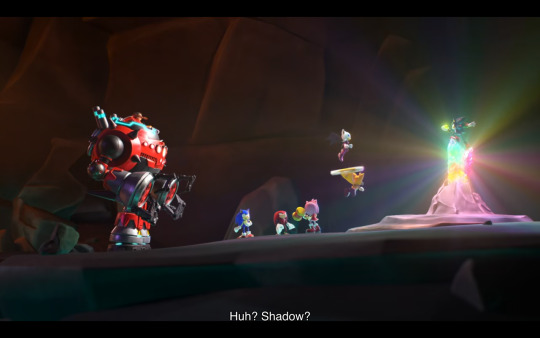
But more importantly, they all came home changed. Sonic is more openly caring, going as far as hugging Eggman when he gets home. 🎲 Similarly, Alan hugs his estranged father at the end of Jumanji (after being chased for 26 years by a hunter conjured from the Jumanji game, played by the same actor as his father), and 🎲 👻 Chihiro thanks the witch Yubaba after the latter is forced to set Chihiro and her parents free - Chihiro even calls the witch ‘granny.’👻
It carries a message about appreciating what you have, even what you perceive as your greatest fear or your worst enemy (because your world isn’t complete if any of them is missing), but especially your closest friends, and trust them to make a brighter future, with or without you.
But you have to do your part. And one day, you might get to see the people you loved and lost again. 🎲 In Alan and Sarah’s case, they do get to see Judy and Peter again, and the latter two sadly don’t remember them: from their perspective, their adventure never happened - yet it makes all the difference, because Alan and Sarah can dissuade their parents from going to the trip that would have gotten them killed. As for whether or not Judy and Peter will ever remember, or become as close to Alan and Sarah as they used to be - we don’t know, but we trust that they will be fine.
On the other hand, we do know that the Jumanji couldn’t be destroyed, and is still out there targeting children for another deadly game - an open ending that is typical of horror movies: the main characters’ story might be over, but the monster remains undefeated. Jumanji might not be advertised as a horror movie, but it uses the trope in a similar way, because this movie is about fighting your fears: Alan and Sarah successfully conquered their fears, but the viewer knows the threat is still out there, and that someone else will inevitably fall into the trap. The message is that fear will always exist, but it can always be conquered. 🎲
📖👻 Neverending Story and Spirited Away take the ambiguity further: the question of whether or not they will see their friends again is left unanswered for both Bastian and Chihiro. The never-ending book is gone from the library when Bastian comes back to his reality: the librarian Mister Correander only gives Bastian the hope that he might get to see the Little Empress of Fantasia again someday, then sends him home to his father (but we don’t actually see Bastian reunite with his father): the ending is open because Neverending Story is all about the power of imagination, and urges the reader to come up with new stories so ‘Fantasia’ can live on. And in Spirited Away, when she gets back to the human world, all Chihiro has left from the Spirit World is the hairband the witch Zeniba gave her for protection, and Haku’s promise to see her again one day. And more importantly, Zeniba’s reassurance that "Once you've met someone, you never really forget them. It just takes a while for your memories to return." 📖👻
Similarly, in Sonic Prime, Sonic is left with a threat from the Chaos Council when they get banished: "You haven’t heard the last of us!" It may well be an empty threat. However, after Sonic goes back to Green Hill and defeats Eggman, a familiar explosion interrupts Sonic’s celebratory picnic with his friends at the end: an explosion that looks just like the blasts the Paradox Prism causes every time someone uses its power on a large scale.
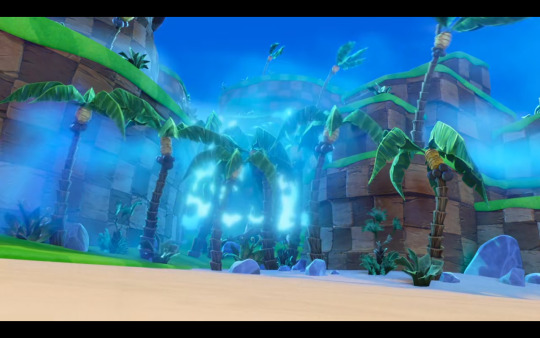
We don’t actually get to see the threat aside from an ominous shadow looming over Sonic and his friends, and Sonic’s exasperated reaction: "You have got to be kidding me." However, whatever the threat is, Sonic doesn’t let it phase him for long: he knows he can face whatever comes at him, because he’s not facing it alone.
We also know that Sonic was about to tell his friends in Green Hill about the Shatterverse before he got interrupted by said explosion, so at the very least, the memories of what happened will be preserved.
And as for us, well; we already know we’ll get to see at least three familiar faces again in Sonic Racing: CrossWorlds. Who knows what might come next?
It’s ultimately up to the viewers to decide how they interpret an ambiguous ending: are the Shatterverse residents only facets of the Green Hill characters, who are the ‘real’ ones? Or are they all their own people, ‘real’ in their own right?
And after the ending, did the Shatterspaces and their residents disappear along with the unbroken Paradox Prism (or ‘fused back’ into their respective Green Hill selves), or are they still living their own lives? If they are, do they remember what happened?
Does the explosion at the end mean that interdimensional travel is still possible? Nine and the Chaos Council did use residual Prism energy to open portals without a Shard in the past, so it might still be possible after the end.
Speaking of Nine, people’s frustration at the ending mostly comes from the uncertainty of his fate: is he fated to stay alone in the Grim in a "be careful what you wish for" type of ending as a narrative punishment for the destruction he caused? Can he actually be happy alone in the Grim, as he claims? Or did his saving the Shatterverse and letting Sonic go set him free, able to use a portal with residual energy to go wherever he wants? After Nine teamed up with them to banish the Chaos Council, would the Resistance forgive him his past betrayal, welcome him back to their home world, and encourage Nine to bring nature back to New Yolk, so they can have the better life they all wanted? Or would Nine change his mind and join Sonic in Green Hill after all?
We don’t know, but the important thing is that the choice is up to Nine: just like Nine had to let Sonic go, Sonic had to stop assuming that he knew what Nine wanted better than Nine did. Both of them stopped trying to project their own wishes onto the other: when Sonic is ready to sacrifice himself, first, he makes everyone "promise to leave Nine alone" and "let him live peacefully in his new home in the Grim," then makes Nine promise he won’t cause any more trouble in the other Shatterspaces either. By doing this, Sonic is respecting Nine’s wishes and letting him have agency: if Nine truly thinks he would rather stay in the Grim, Sonic will let him. And when all is said and done, Nine hugging Sonic goodbye (initiating it for the first time) shows that he has grown enough to be more honest about his own emotions, and let himself be vulnerable, even in front of people he used to see as enemies.
But the more important part is Sonic’s parting words to all of the Shatterverse residents before he has to leave them for good. All Sonic can really ask of them at the end is:
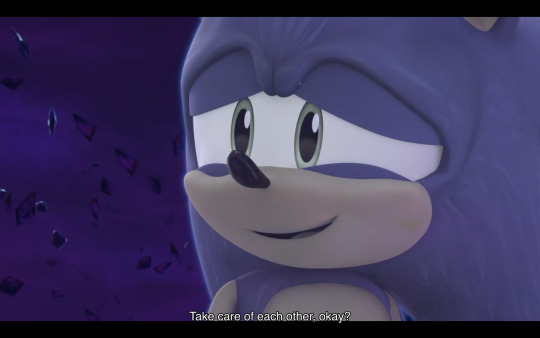
This is directed at all of them, including Nine - and if they all take it to heart and do decide to help each other out, then Nine should be fine.
That being said, the ending is still up to interpretation. Personally, I think the evidence points to all the characters being real and able to exist in their separate worlds even after the ending; it would be a fitting symbol of friendship transcending time and space, even if it is wrapped in uncertainty.
However you interpret them, there is something poetic about ambiguous endings for stories like Sonic Prime’s: they illustrate that relationships are always fragile and full of uncertainties; just like the Paradox Prism. And that’s all the more reason to treasure them.
45 notes
·
View notes
Text
I will never forget the ask I got a while ago now, regarding my AU, Metal Breakers.
“We need more Metal Breaker Kit being unfathomably gay for Tails.”
It lives rent free in my head, and every chance I get I use it as fuels to motivate me to write that smug little shit taking any opportunity he can to remind Tails he is loved, even if he acts like doesn’t want to be loved.
7 notes
·
View notes
Text

I decided to go back and finish my silly Gaster from my post last night.
This is the Canon Gaster btw but none ya'll ready for it.
12 notes
·
View notes
Text
tails and charmy should interact more i think they'd have a hysterical dynamic. sure them being friends is very cute but what if they had like... a strained dynamic
like. tails is the smart mature kid and charmy is the worlds most bitchiest toddler. their personalities clash like a car crash. a housefire has the same exact chemistry as their dynamic. charmy would annoy tails so much that he ages like 20 yrs everytime charmy gets within eight feet of him. i can imagine charmy going around tails's house/workshop picking up random shit like "what does this do? what does this do? what's this?? can i touch your tails?? why are your ears so big????? what's th--" and it makes tails want to DIE. it doesn't help that charmy has a habit of literally popping up out of thin air like a fucking fnaf 2 jumpscare so tails has to constantly keep looking over his shoulder like he owes the mafia money or some shit
charmy would call tails a dork, a dweeb, a pointdexter, etc etc 24/7 and tails cant do a damn thing about it because he has to be the mature older kid. everytime tails is asked (READ: FORCED) to have a playdate/help babysit charmy and cream he has to put up with dumb shit like listening to charmy explain how to get out of paying taxes or listening to cream cry because tails refused to play dress up with her and cheese. hell. hell on earth. at this point tails wishes that shadow had kicked him in the back of the head a little harder the last time they scrapped because laying comatose in a hospital sounds way better than having to listen to two little kids whine and yap constantly
as someone who's the oldest sister of two younger boys... little boys tend to beef over the DUMBEST shit ever. charmy would tell cream that Earth birds are actually government spy drones implemented by G.U.N and tails is like "no they aren't????" and charmy's just "SHUT UP FOX BOY U DONT KNOW WHAT UR TALKING ABOUT!!" and it starts a huge argument. the fallout was catastrophic. but it's fine they made up in like three days lol
28 notes
·
View notes
Note
Can you please post the Brutus art piece as its own post 🙏
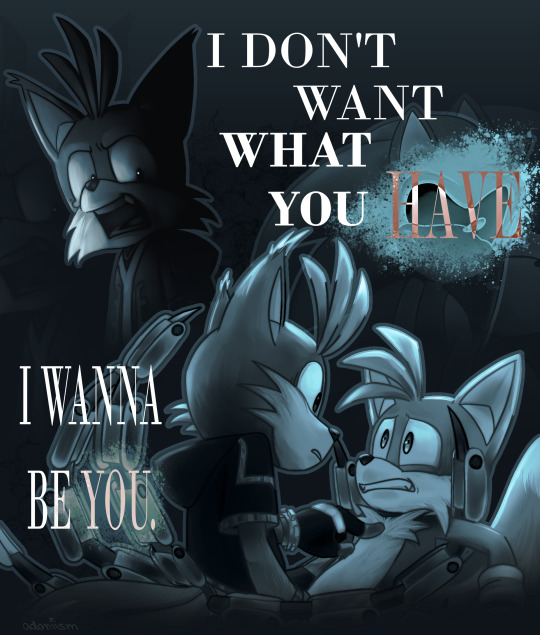
BRUTUS BRUTUS.
185 notes
·
View notes
Text



sonic and tails yayy wait..whats that… im scared…..
3K notes
·
View notes
Note
You know Miles. You could fire Chris if you don't feel comfortable with him constantly hitting on you. Unless of course, you like that?
"Don't be ridiculous. Kit may have his... quirks... but he’s proven his usefulness," Tails said firmly, his arms folded and expression serious. "He’s loyal, reliable, and hasn’t gotten himself killed on any of our expeditions. That already puts him above half the people I’ve worked with. Just because he can be... occasionally..." He paused, his eyes shifting to Kit, who was lounging nearby with a smug little smile. "...irritating, doesn’t mean I should fire him. He’d be too difficult to replace."
Kit tilted his head, grin widening. "What’s with the sudden shift, Tails~? You tell me all the time you can fire me whenever you want~"
"Because I can!" Tails snapped, his two tails lashing behind him like. His ears folding flat against his head as he glared at Kit.
"No you can’t~" Kit replied in a sing-song voice, clearly enjoying himself.
"YES I CAN!" Tails shouted, his voice cracking slightly with frustration.
Kit leaned forward, eyes gleaming. "Then what if I were to quit, huh? What if I quit right now? Would you try to stop me?"
Tails growled, trying to hold onto his anger, trying to stay sharp and unbothered. But the tension in his face softened. The redness creeping into his cheeks betrayed him. His mouth opened as if to say something, but no words came. Instead, he turned on his heel and stormed out of the room without another sound.
Kit chuckled, leaning back with smug satisfaction. "Hahaha, that’s what I thought."
9 notes
·
View notes












